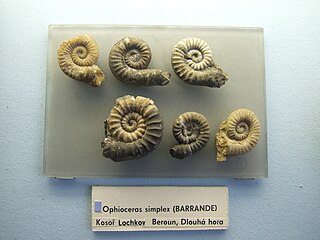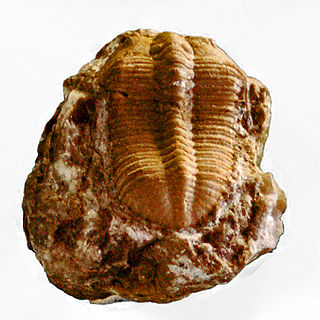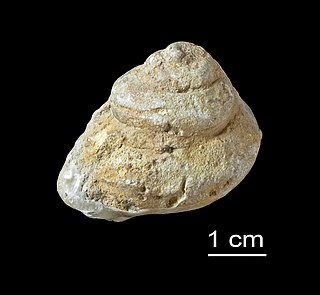Murchisoniceras is an extinct genus of cephalopod Nautiloid, that lived during the Silurian from 425 to 416 mya, in what would be Europe, existing for approximately 9 million years.
Arionoceras is an extinct orthocerid genus from the Middle and Upper Silurian, of Europe that is estimated to have lived from 422.9 to 418.1 mya, existing for approximately 4.8 million years.
Bogoslovskya is an extinct genus of actively mobile carnivorous cephalopod that lived in what would be Europe during the Silurian from 422.9—418.7 mya, existing for approximately 4.2 million years.
Hemicosmorthoceras is an extinct genus of actively mobile carnivorous cephalopod, essentially a Nautiloid, that lived in what would be present day Europe during the Silurian to Devonian from 422.9—412.3 mya, existing for approximately 10.6 million years.
Leurocycloceras is an extinct genus of actively mobile carnivorous cephalopod, essentially a Nautiloid, that lived in what would be North America, Europe, and Asia during the Silurian from 443.7—418.7 mya, existing for approximately 25 million years.
Neosichuanoceras is an extinct genus of actively mobile carnivorous cephalopod, essentially a Nautiloid, that lived in what would be Asia during the Silurian from 436.0 to 428.2 mya, existing for approximately 7.8 million years.
Orthocycloceras is an extinct genus of actively mobile carnivorous cephalopods, essentially a Nautiloid, that lived in what would be Europe during the Silurian to Devonian from 428.2 to 412.3 mya, existing for approximately 15.9 million years.
Parasphaerorthoceras is an extinct orthocerid genus, a nautiloid cephalopod, that lived in what would be Europe and north Africa during the Silurian from 422.9 to 418.1 mya, having existed for approximately 4.8 million years.
Sactoceras is an extinct nautiloid cephalopod that lived during the Ordovician and Silurian in what would become North America, Europe, and Asia.
Vericeras is an extinct genus of nautiloid cephalopod that lived in what would be Europe during the Silurian from 421—418.7 mya, existing for approximately 2.3 million years.

Ophioceras is a genus of closely coiled tarphycerid nautiloid cephalopods, the sole representatives of the family Ophidioceratidae, characterized by an evolute shell with narrow, subrounded, annulated whorls and a subcentral siphuncle composed of thin connecting rings that show no evidence of layering. The mature body chamber is strongly divergent and is the longest proportionally of any tarphycerid. The aperture has a deep hyponomic sinus and ocular sinuses, and so resembles some lituitids.

Pachydesmoceras is a genus of ammonites belonging to the family Desmoceratidae.

Calycoceras is an extinct genus of cephalopods belonging to the subclass Ammonoidea and family Acanthoceratidae that lived during the Cenomanian stage of the Late Cretaceous, 100-94 Mya. Their shells had ornate ribs.

Hercoceras is a genus of trochoidally coiled nautiloid cephalopods placed in the nautilid family Rutoceratidae. These cephalopod lived i in the Eifelian age of the middle Devonian Period, which occurred 398-391 million years ago. Their shells have prominent lateral outgrowths in the form of spines and a high intraspecific variability.

Metacalymene is a genus of trilobites in the order Phacopida, family Calymenidae. This genus is considered monotypic, containing only the type species:

Planiscutellum is a genus of trilobites in the order Corynexochida family Styginidae. These trilobites were nektobenthic detritivore. They lived in the Silurian period in the upper Ludlow epoch, from 422.9 ± 1.5 to 418.7 ± 2.8 million years ago.

Crotalocrinites, also known as the feather star, is a genus of extinct sea lily belonging to the family Crotalocrinitidae. These feather stars were stationary intermediate-level organisms feeding on suspension epifauna. They lived in the Silurian period, from the Upper Wenlock age to the Ludlow age.

Belemnites is a genus of an extinct group of cephalopods belonging to the order Belemnitida. These cephalopods existed in the Early Jurassic period from the Hettangian age to the Toarcian age (175.6–183.0). They were fast-moving nektonic carnivores.

Holopea is an extinct genus of fossil sea snails, Paleozoic gastropod mollusks in the family Holopeidae.

Peismoceras is a genus of fossil Cephalopoda in the family Lechritrochoceratidae.










